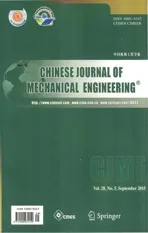Effects of Driving Mode on the Performance of Multiple-Chamber Piezoelectric Pumps with Multiple Actuators
2015-01-20ZHANGZhonghuaKANJunwuWANGShuyunWANGHongyunMAJijieandJIANGYonghua
ZHANG Zhonghua,KAN Junwu*,WANG Shuyun,WANG Hongyun,MA Jijie,and JIANG Yonghua
Institute of Precision Machinery,Zhejiang Normal University,Jinhua 321004,China
1 Introduction
Micropumps are becoming increasingly important for a wide range of applications,such as,pharmaceutical and bio-medical drug delivery systems,serving as micro-fluid flow control appliance for analyzing systems for chemical and biological substances[1–3].Because micropumps have the unique ability to deliver an accurate amount of liquid,many different types of micropumps have been developed using several actuation methods such as,electrostatic,piezoelectric,thermopneumatic,electrochemical,shape memory alloy(SMA),and electromagnetic[4].Among the various kinds of working principles,piezoelectric actuation is promising due to its relatively simple structure,low cost,short response time,good reliability and low power consumption[4].Furthermore,piezoelectric actuation is the first actuation principle used for micropumps[5].Unsurprisingly,a large number of papers on piezoelectric actuation for micropump applications have been published.Research and development on piezoelectric pumps have made considerable progress in the last three decades.VALDOVINOS,et al[6],developed a piezohydraulic pump used in pulsatile pediatric ventricular assist devices.LENG,et al[7],presented a spiral-tube-type valveless piezoelectric pump with gyroscopic effect.TANAKA[8]used a very flexible and ultra-thin glass sheet to realize a peristaltic pump installed on an entirely glass-based microchip.HU,et al[9],developed a piezoelectric-stack pump with variablecross-section oscillating vibrator.ZHANG,et al[10],proposed a piezoelectric micropump with an integrated sensor based on space-division multiplexing.
The classic piezoelectric pump consists of a pump chamber with a diaphragm(pumping membrane) and two passive check valves.The diaphragm,actuated by a piezoelectric disk glued onto it,generates a stroke volume and causes pressure for suction and discharge flow alternately—just like the pumping principle of the human heart.Although micropumps using piezoelectric actuation have the many advantages herein mentioned,their high operational voltages and small volume stroke are considered disadvantageous[11–12].Similarly,many studies over the last three decades have been done on piezoelectric pumps with the goal of achieving higher performance at lower actuation voltage.As a result,some optimization of the geometrical design of piezoelectric pumps was investigated[13].WANG,et al[14–15],introduced a folded piezoelectric vibrator and two fixed ends polydimethylsiloxane valves in order to increase the flow rate.HAM,et al[16],presented the design and fabrication of a piezoelectric pump using hinge-lever amplification mechanism.The pump achieved no-load flow rate,maximum output pressure of 600 ml/min,and 6.8 kPa,at the applied voltage of 100 V.LI,et al[17],developed a robust,passive high-frequency high-pressure micro check valve for piezoelectrically actuated pumps.Integrated with a compact piezoelectric pump,the microvalve could produce a pressure of 2.4 MPa at 10 kHz frequency.Because further enhancement of the single-chamber pump performance was limited,piezoelectric pumps with double or even multiple actuators and chambers were successfully proposed and developed.ULLMANN[18]analyzed the performance of one single-chamber and one doublechamber piezoelectric valveless pumps,and found that the double-chamber pump yielded a significant improvement over its single chamber counterpart.Two serial-and parallel-connection valveless piezoelectric pumps were then fabricated in the study.The performance characteristics of the different combinations were reported and critically evaluated[19].ZHANG,et al[20],developed a double-actuator piezoelectric pump with flow rate self-sensing capability.KIM,et al[21],investigated the effect of phase shift on optimal operation of serial-connected double-chamber valveless micropumps.KAN,et al[22],proposed a serial-connection quadruple-chamber piezoelectric pump with cantilever valves and verified through experiment results that the flow rate and backpressure of the serial-connection multiple-chamber pumps had increased with the increase in the number of pump chambers.So far,in the author’s best knowledge,relatively little research has been performed on the multiple-chamber and multiple-actuator piezoelectric pumps.
In this paper,the effects of driving mode on the performance of multiple-chamber piezoelectric pumps with multiple actuators are studied through experiment.In the study,the driving mode mainly referred to the connection mode and actuated sequence of the piezoelectric actuators.KAN,et al[22],verified that the chamber number had an influence on multiple-chamber pump performance.However,in the results of the present study,properties of the multiple-chamber pump changed significantly with different working chambers even though the number of pumping chambers was the same.In another sense,these results mean that the multiple-chamber pump is able not only to produce robust liquid propulsion at low energy consumption,but also offer a high level of flexibility in terms of flow rate and backpressure.Through basic experiments on frequency characteristics,the effects of driving mode on the output characteristics of the multiple-chamber and multiple-actuator pump were investigated.This work is beneficial in that,it offers a thorough understanding of the working properties of multiple-chamber pumps,making improvement of those working properties possible.Moreover,it demonstrates how to utilize multiple-chamber pumps effectively and how to adjust their optimal performance according to different application requirements.This study was also expected to explore a new way to control pumping rate and pressure,which could be achieved by changing the working modes of multiple-chamber pumps rather than the driving voltages.This technique would be especially suitable in a situation where the voltage amplitude cannot be adjusted.
2 Structure and Working Principle of the Multiple-Chamber Pump
The multiple-chamber and multiple-actuator pump in the present work consists of five piezoelectric diaphragms used as actuators,six check valves,five pump chambers,a pump body,an inlet,and an outlet (Fig.1).

Fig.1.Structural schematic diagram of the multiple-chamber piezoelectric pump with multiple actuators
In Fig.1,Ai(i=1,2,…,5),Cj(j=1,2,…,5),andVk(k=1,2,…,6),are the actuators,chambers,and check valves,respectively.The five piezoelectric actuators,which are the core components of the pump,are from commercial circular diaphragms produced by Murata Manufacturing Co.,Ltd.The main parameters of the circular diaphragm are listed in Table 1.

Table 1.Main parameters of the piezoelectric diaphragm
The pump body is made of polymethyl methacrylate(PMMA) which has advantageous properties of easy processing,light weight,insulation,and easy observation.The six umbrella-shaped check valves made of rubber are used to separate the chambers.The structural form of the multiple-chamber pump can be simply described as:the inlet and the outlet of the five single-chamber pumps are connected serially and separated by the check valves.The prototype pump with the dimensions 170 mm×50 mm×20 mm is shown in Fig.2.
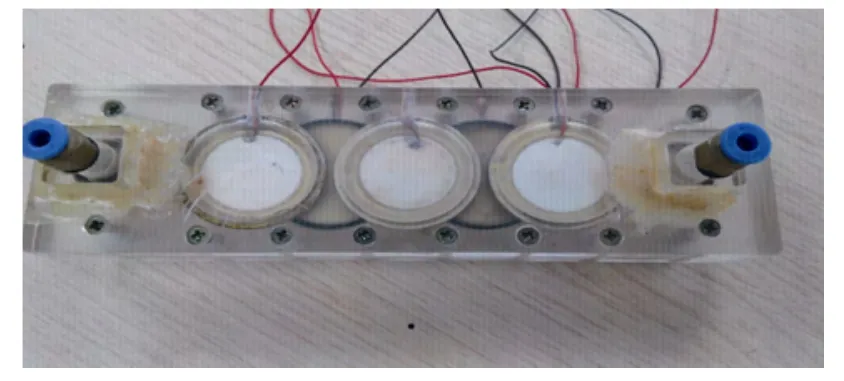
Fig.2.Photograph of the multiple-chamber piezoelectric pump
Fig.3 shows the working principle of the serialconnection multiple-chamber piezoelectric pump when all the actuators are operating.The asynchronous operation mode of working piezoelectric actuators is needed in order to make the serial-connection pump run more efficiently.The phase difference of driving voltages between the working actuators near the border is 180°;that is,the diaphragm actuators of the pumping chambers near the border are operating in an anti-phase mode[22].In response,the adjacent working actuators generate opposed deflection,which results in the increase of one chamber volume and the decrease of the next chamber volume.When the pump chamber volume becomes enlarged,an underpressure is generated in the chamber and fluid flows into the chamber through the inlet valve(Fig.3(a)).When the pump chamber volume is reduced,an overpressure is generated in the chamber and the fluid flows through the outlet valve(Fig.3(b)).When alternating voltage is applied to the piezoelectric actuators,the diaphragms are actuated to produce bending deformation,which then causes volume change in pump chambers alternately.Working fluid is drawn into the pump chamber during the chamber expansion/suction stroke and forced out of the pump chamber during the contraction/discharge stroke.As a result,the working fluid is continuously delivered from one chamber to the next.The liquid is then moved from the inlet to the outlet of the multiple-chamber pump.Note that this case,that all the actuators are simultaneously working,was only taken as an example to demonstrate the working principle of the multiple-chamber pump.In reality,the multiple-chamber pump can move working fluid only when there is at least one working actuator,in which case,the chamber with the inactive actuator is equivalent to the fluidic channel.When more than two piezoelectric actuators are working,piezoelectric actuators of the pumping chambers near the border will be operated in an anti-phase mode.Otherwise,the pump can not possibly move the fluid.For example,when the first two actuators ofA1andA2are at work and operated in an in-phase mode,the middle valveV2will not work and become a load.This paper mainly studies the dynamic performance of the multiple-chamber pump with various combinations of multiple driving chambers,in terms of flow rate and backpressure.
3 Experimental Setup
To explore the characteristics of the multiple-chamber and multiple-actuator pump under different driving modes,pump performance in terms of flow rate and backpressure needs to be tested.The overall arrangement of the testing apparatus is illustrated in Fig.4.
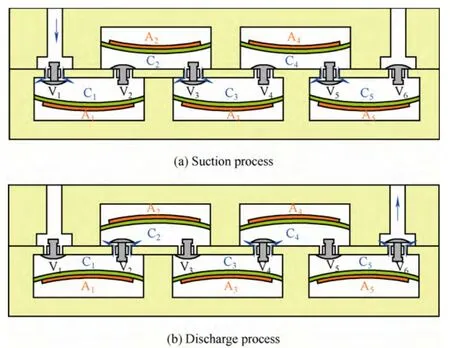
Fig.3.Working principle of serial-connection multiple-chamber piezoelectric pump
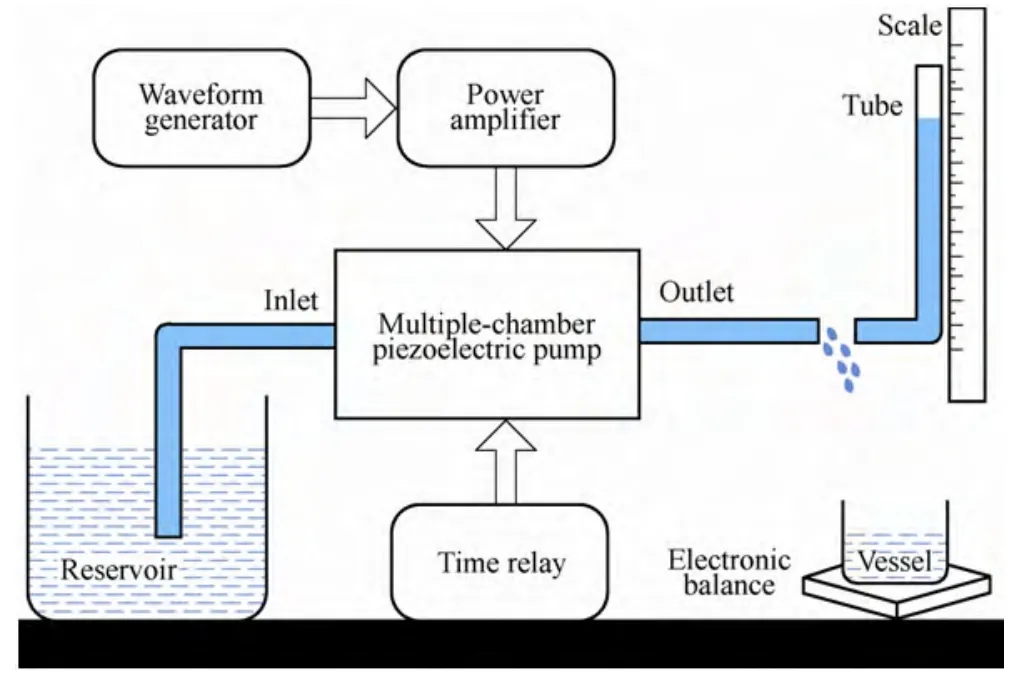
Fig.4.Experimental setup
Tap water at room temperature,as the best representative of working fluid,was used as working medium.A large reservoir ensured a constant height and a constant inlet pressure during the measurement.The inlet and outlet of the pump were connected to the liquid reservoir by plastic tubes.A digital PZT power supply(SANKI,P211) was used to drive the piezoelectric pump.The power supply could provide a variable frequency of 60-400 Hz and an AC voltage range of 0-240 V.An electronic balance(Ohaus,CP1502C) was used to measure the flow rate.The main technical parameters of the balance are as follows:a measurement range of 1510 g,a division value of 0.01 g and a repeatability of 0.01 g.According to the energy equation[23],the water column height which was perpendicular to the water free surface was measured by a scale ruler in order to obtain the pumping pressure value.A time relay was used to set the time interval to achieve the average flow rate and the time interval of sixty seconds was set in each measurement.The resulting mass that would be measured by the balance was the value of the average flow per minute.Using this setup,a series of experiments were conducted at a fixed driving voltage of 150 V and in a maintained frequency range from 60 Hz to 400 Hz to obtain the effects of driving mode on the performance of the multiple-chamber piezoelectric pump with multiple actuators.
4 Experiments
Generally,flexibility,in terms of pumping flow rates,increases as the number of chamber increases.The quintuple-chamber pump in this study could run in modes from a single actuator to quintuple actuators,according to different application requirements.Because this paper focuses on the effects of driving mode on the performance of multiple-chamber piezoelectric pumps,the study of the pump with more than two working actuators was mainly carried out here.In any case,the number of actual working actuators represents the number of chambers for this multiple-chamber pump.Then,we successively tested the output characteristics of the pump with different working piezoelectric actuators,paying special attention to the pump with the same number of chambers and different positions of working actuators.
4.1 Results for the pump with double actuators
To carry out this experiment,every two piezoelectric actuators of the pump needed to be simultaneously connected with the sinusoidal AC power.Moreover,the double actuators needed to be operated in the asynchronous mode,thereby forming ten serial-connection doublechamber(double-actuator) piezoelectric pumps were one after another.While adjusting actuation frequency gradually,the flow rate(ml/min) versus frequency(Hz) characteristics of the double-chamber pumps were first tested at a fixed driving voltage of 150 V.Fig.5 shows the resulting double-chamber pump performance in terms of flow rate versus actuation frequency.

Fig.5.Flow rate versus actuation frequency of the pump with double actuators at a driving voltage of 150 V
On one hand,the performances of ten double-chamber pumps vary significantly from two different working actuators.On the other,the flow rate versus frequency curve of the pump withA1/A2working almost coincides with that of the pump withA4/A5working.The flow rate increases with the frequency within almost the entire range from 60 Hz to 400 Hz.The maximum flow rate of 279.6 ml/min is measured at 400 Hz and at a driving voltage of 150 V.Something similar occurs whenA2/A3andA3/A4,as well asA1/A3andA3/A5,are at work.Moreover,when the frequency is smaller than 260 Hz,there is no remarkable performance difference between the pumps withA1/A2,A1/A3,A3/A5,andA4/A5working.As results show,the flow rate versus frequency curves of the pump withA1/A4,A1/A5,andA2/A5working are also very coincidental when the frequency is smaller than 120 Hz.All three curves reach their peak at the frequency of 100 Hz.Additionally,there remains a similar trend for the two curves withA1/A4andA2/A5working even though the frequency is greater than 120 Hz.
The above-described experiments preliminarily display the characteristics of the pump with different double actuators.To continue,because the serial-connection pumps could be very helpful in improving backpressure and flow rate,the backpressure versus frequency characteristics of the double-chamber pumps were also tested.After transforming the measured water column height into the pressure value,the results are obtained.Fig.6 shows the resulting double-chamber pump performance in terms of backpressure versus actuation frequency,at a fixed driving voltage of 150 V.It is observed that the backpressure versus frequency curves of the pump withA1/A2,A2/A3,A2/A4,andA3/A4working are similar within the whole frequency range.In these situations,the pump achieves a maximum backpressure of 7.05 kPa at around 140 Hz to 160 Hz and then shows a relatively good backpressure stability when the frequency is greater than 180 Hz.The curve withA1/A3working is also similar to the configurations mentioned above when the frequency is smaller than 240 Hz.Other curves in the experiment show relatively big backpressure fluctuation,especially whenA5actuator is involved.
4.2 Results for the pump with triple actuators
In this section and the two that follow,the experiment procedures are basically the same with the procedure used for the pump with double actuators,except that the number of piezoelectric actuators connected simultaneously with the power supply are three,four,and five,respectively.Moreover,it is noted that the piezoelectric actuators of the pumping chambers near the border are operated in an anti-phase mode.When three piezoelectric actuators were simultaneously connected with the power supply in turn,ten serial-connection triple-chamber piezoelectric pumps were also formed.Figs.7 and 8 show the experiment results for the performance of the ten triple-chamber pumps in terms of flow rate and backpressure versus actuation frequency,respectively.In contrast with the earlier discussed double-chamber pumps,although the flow rate increases modestly,the backpressure of the triple-chamber pumps increases significantly.
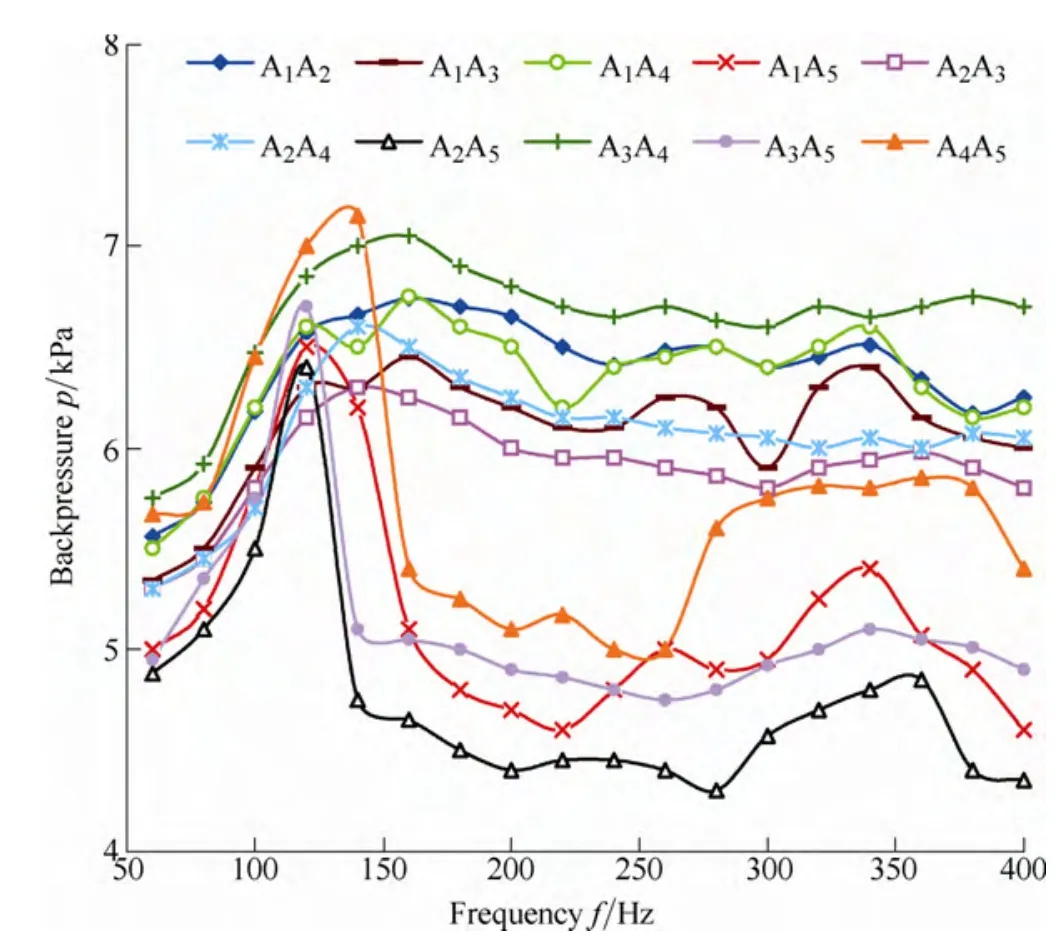
Fig.6.Backpressure versus actuation frequency of the pump with double actuators at a driving voltage of 150 V
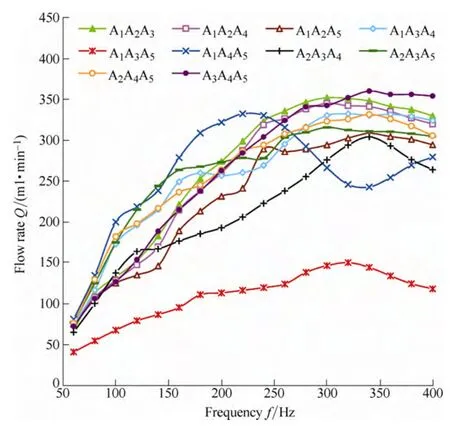
Fig.7.Flow rate versus actuation frequency of the pump with triple actuators at a driving voltage of 150 V
In the experiment,after the flow rate-frequency characteristic of the pump withA1/A2/A3working is tested,the flow rate decreases slightly withA4substituting forA3.The maximum flow rate decreases from 352 ml/min to 345.2 ml/min.The decrease of the flow rate becomes more obvious whenA5is substituted forA3,wherein the maximum flow rate decreases from 352 ml/min to 308.4 ml/min.Furthermore,the flow rate of the pump withA1/A3/A5working decreases sharply whenA5is substituted forA2,wherein the maximum flow rate can reach only up to 150.4 ml/min.In contrast,the flow rate versus frequency curves of the pump withA1/A2/A3,A1/A2/A4,andA3/A4/A5working are almost coincidental within the whole frequency range.Likewise,the curve of the pump withA2/A3/A4working takes on a similar trend when the frequency is smaller than 120 Hz.Three other curves,those for pumps withA1/A3/A4,A2/A3/A5,andA2/A4/A5working,also take on a similar trend.Although the curve of the pump withA1/A4/A5working also shows a similar trend when the frequency is smaller than 120 Hz,the flow rate fluctuation becomes slightly big when the frequency is greater than 120 Hz.Fig.8 demonstrates that most of the ten triple-chamber pumps have similar backpressure versus frequency characteristics.Notably,the maximum backpressure of almost all triple-chamber pumps is achieved at around 120 Hz;for example,a maximum backpressure of 9.8 kPa is recorded at the frequency of 120 Hz for the pump withA1/A2/A3working.
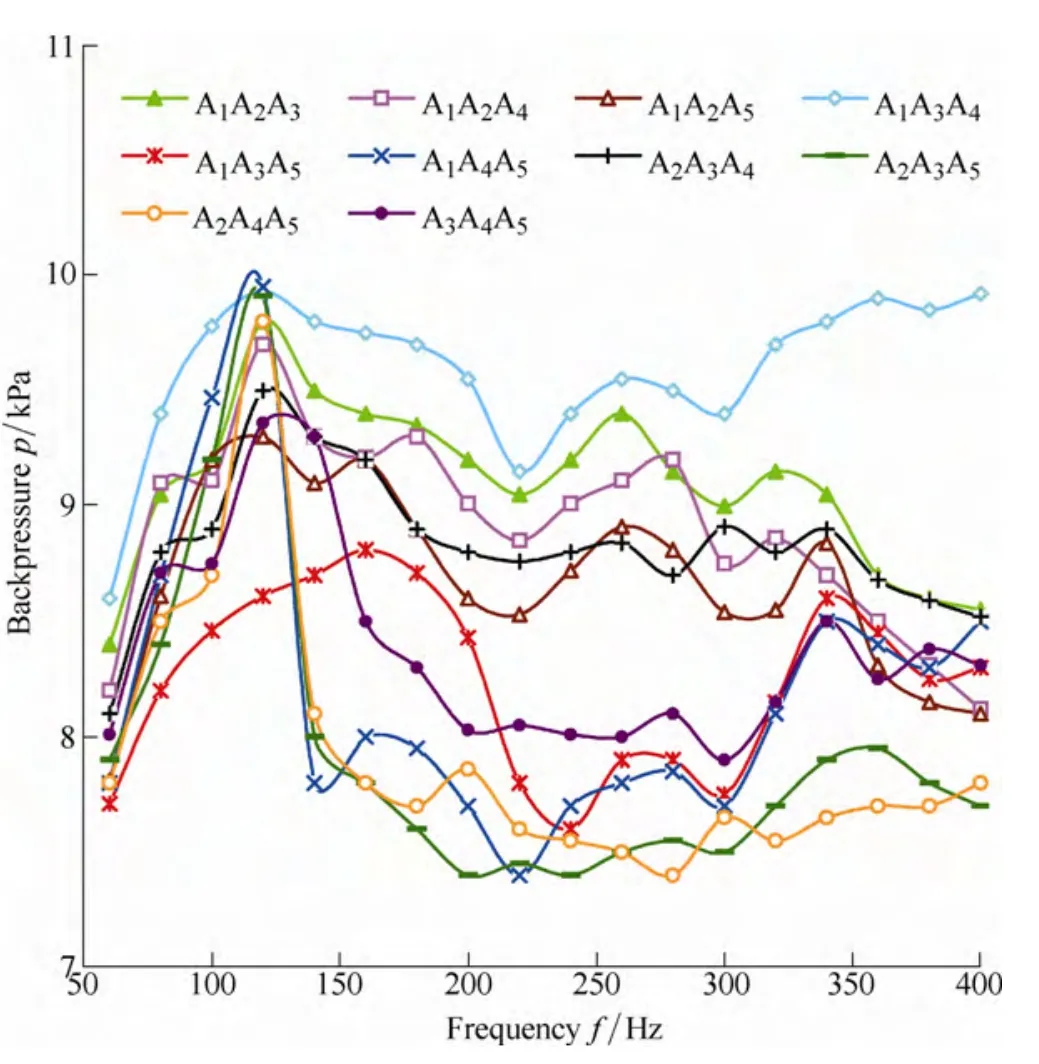
Fig.8.Backpressure versus actuation frequency of the pump with triple actuators at a driving voltage of 150 V
4.3 Results for the pump with quadruple actuators
In this section,the experiment results involving the pump with quadruple actuators are immediately presented because the experiment procedures applied are very similar to the previously discussed experiments.Figs.9 and 10 show the experiment results for the performance of the five quadruple-chamber pumps in terms of flow rate and backpressure versus actuation frequency,respectively.In contrast with the triple-chamber pumps,although the flow rate of the quadruple-chamber pumps increases moderately,the backpressure increases significantly.The maximum backpressure reaches 12.9 kPa at an actuation frequency of 100 Hz,which is about 1.31 and 1.91 times larger than that of the triple-chamber pump withA1/A2/A3working and the double-chamber pump withA1/A2working,respectively.
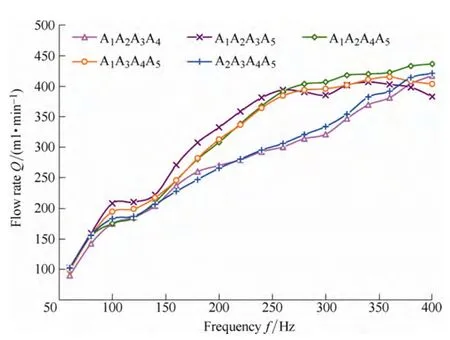
Fig.9.Flow rate versus actuation frequency of the pump with quadruple actuators at a driving voltage of 150 V
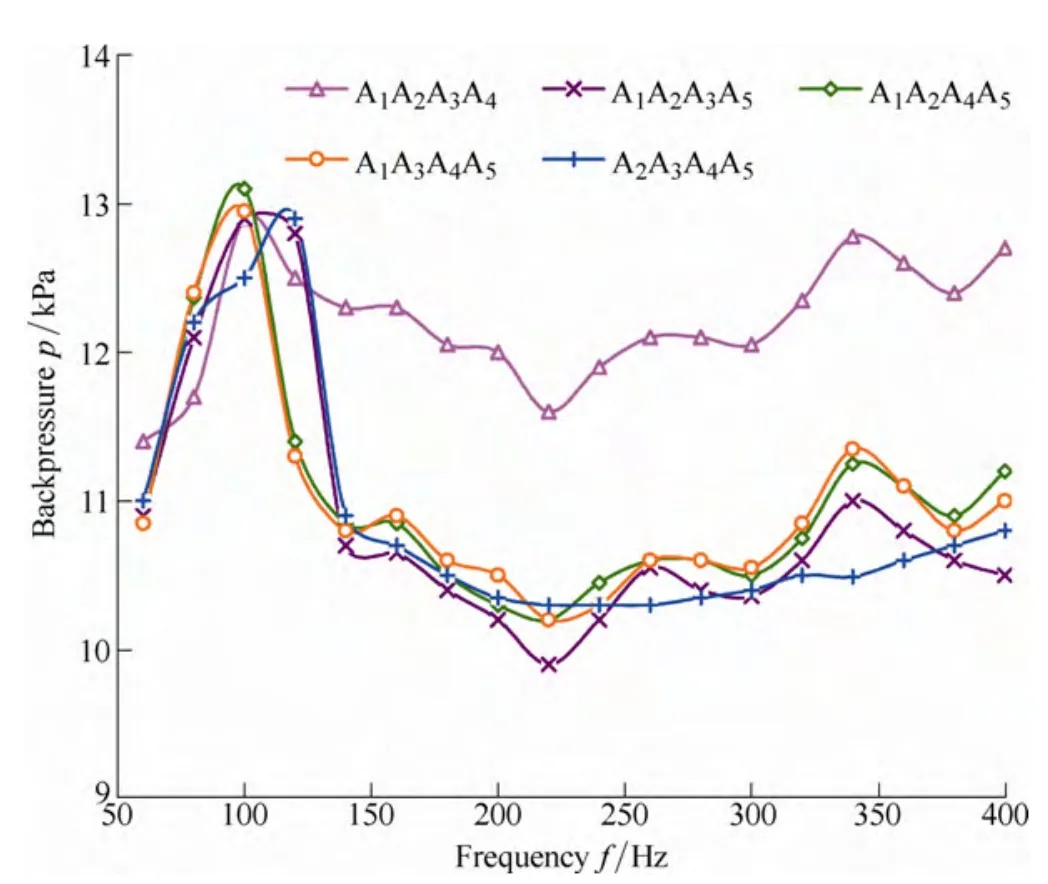
Fig.10.Backpressure versus actuation frequency of the pump with quadruple actuators at a driving voltage of 150 V
Fig.9 demonstrates that,in general,the flow rate of all the five quadruple-chamber pumps increases with the frequency.Moreover,the five flow rate-frequency curves are very similar when the frequency is smaller than 140 Hz.Specifically,within the whole frequency range,the flow rate versus frequency curve of the pump withA1/A2/A3/A4working almost coincides with the curve of the pump withA2/A3/A4/A5working.The pump achieves a maximum flow rate of 417.2 ml/min at the actuation frequency of 400 Hz.The pump also displays very similar characteristics whenA1/A2/A3/A5orA1/A3/A4/A5are working.Furthermore,the flow rate-frequency curve of the pump withA1/A2/A4/A5working almost coincides with those two curves when the frequency is smaller than 260 Hz.However,Fig.10 demonstrates that the pump withA1/A2/A3/A4working has relatively good frequency stability;its backpressure versus frequency characteristics are the best compared with the four other quadruple-chamber pumps.The backpressure versus frequency curves of the five quadruple-chamber pumps are very similar when the frequency is smaller than 100 Hz.When the frequency is greater than 100 Hz,however,except for the curve withA1/A2/A3/A4working,the other four curves display a big decline in the backpressure.This infers that the performance of the quadruple-chamber pump becomes poor when theA5actuator next to the outlet is involved.
4.4 Results for the pump with quintuple actuators
In this situation,it would be useless to experiment on the effects of driving mode on the multiple-chamber pump because all the piezoelectric actuators would take part in running the pump.At the same time,this situation represents the maximum work ability of the serialconnection multiple-chamber pump under this kind of driving mode.To demonstrate the performance of the quintuple-chamber pump and to compare it with the previously discussed pumps with different driving modes,frequency characteristics were herein also tested.Similarly,the experiment results for the serial-connection quintuplechamber pump are immediately presented.Figs.11 and 12 show the experiment results for the performance of the quintuple-chamber pump in terms of flow rate and backpressure versus actuation frequency,respectively.
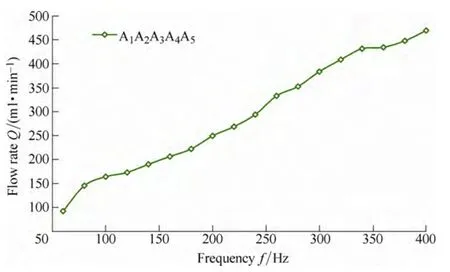
Fig.11.Flow rate versus actuation frequency of the pump with quintuple actuators at a driving voltage of 150 V
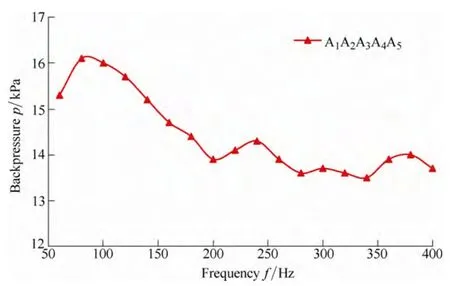
Fig.12.Backpressure versus actuation frequency of the pump with quintuple actuators at a driving voltage of 150 V
Unlike with the quadruple-chamber pumps,the flow rate of the quintuple-chamber pump increases slightly.However,the backpressure increases significantly.As demonstrated in Fig.11,the increase of the flow rate with the frequency is nearly linear within the whole frequency range from 60 Hz to 400 Hz.The pump achieves a maximum flow rate of 469.2 ml/min at the actuation frequency of 400 Hz,which is approximately 1.12,1.33,and 1.68 times larger than that of the quadruple-chamber,triple-chamber,and doublechamber pumps,respectively.In Fig.12,however,results show that the backpressure obviously increases with the number of chambers.The maximum backpressure reaches 16.1 kPa at an actuation frequency of 80 Hz,which is about 1.25,1.64,and 2.39 times larger than that of the quadruple-chamber pump withA1/A2/A3/A4working,the triple-chamber pump withA1/A2/A3working,and the double-chamber pump withA1/A2working,respectively.
5 Discussion
As the previously discussed experiments describe,the performance of a multiple-chamber piezoelectric pump is mainly studied using various combinations of multiplechamber actuation.Experiment results show that as the combinations of driving chambers change,pump performance changes in terms of flow rate and backpressure.Moreover,both flow rate and backpressure vary remarkably with different actuation chambers even if the number of driving chambers is same.There is no denying the difference between the piezoelectric actuators even though these five actuators come from one production batch.The actuator’s difference is just the one of the possible reasons.For the multiple-chamber pump,the opening and closing movement of the middle valves are caused by the simultaneous changing of liquid pressure in the two actuation chambers near the border(one actuation chamber pushes and the other pulls).In the check-valve piezoelectric pumps,the pull capability of the actuation chamber is weaker than its push capability;this characteristic of the actuation chamber is the main reason why the dynamic performance of the multiple-chamber pump changes significantly with different actuation chambers.When the working actuators are close to the inlet,the idle check valves are opened through the relatively strong push capacity.Meanwhile,the idle check valves are opened through the relatively weak pull capability when the working actuators are close to the outlet.Evidently,the idle check valves have completely become loads even though fluid and backpressure transmission can also be achieved in the non-working chambers.
The check efficiency of check valves becomes another important factor that influences the working properties of multiple-chamber pumps with different actuation chambers.The check efficiency denoted byηis defined as[24-26]


where Δpneg—Pressure loss in negative flowing direction,
Δppos—Pressure loss in positive flowing direction,
Vt—Theoretical discharge volume,
Vm—Back-flow volume per cycle.
According to Refs.[24]-[26],the pressure loss is denoted as

ρ—Fluid density,
ξ—Loss coefficient dependent on the conduit geometry and the flowing direction.
Check efficiency is not merely relevant to the abovementioned parameters.The phase shift(φ,between the movement of the valve and actuator) has great influence on check efficiency as well,because opening/closing of the passive check valves always lags behind the vibration of the piezoelectric actuators[22,27].The check efficiency decreases when the phase shift increases(η∝1φ).When the multiple-chamber pump runs in various driving modes,the difference in relative distances between the working actuator and the check valves will directly result in a difference in the phase shift,which makes the check efficiency of the valves differ from each other.Therefore,the check efficiency of check valves further influences the characteristics of the pump even if the number of working chambers is same,as demonstrated in the experiments.
Results show that backpressure is significantly different when driving modes are changed,and doubles with the number of pumping chambers,leading to a wide variety of fluid compressibility.Therefore,the fluid compressibility also has a great effect on pump performance.The bulk modulus of the fluid is a reciprocal of the compressibility,and is given as[28–29]

whereβe—Bulk modulus of the fluid,
ΔV—Volume change of pump chamber,
p—Pressure generated in the chamber before the liquid is discharged,
Vo—Original chamber volume.
The negative sign denotes that volume decreases with a corresponding increase in pressure.Given the liquid beginning to be discharged from chamber at pressurepand not being compressed further,the total volume displacement ΔVoutof pump chamber depends mainly on the pressurep[30–31]:
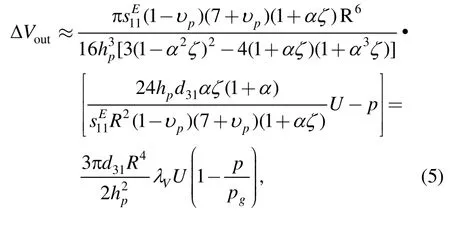
wherepg—Maximal liquid pressure generated by
piezoelectric actuator under an applied voltage,
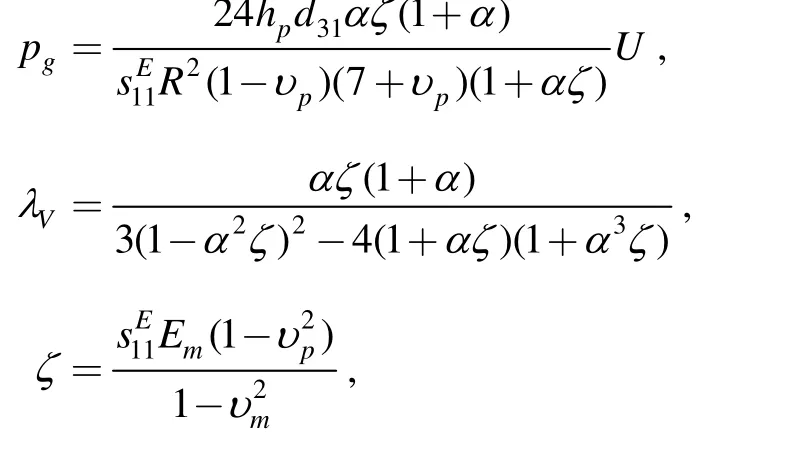
—Elastic compliance coefficient of piezo-disk,
Em—Elastic modulus of metal plate,
υp—Poisson’s ratios of piezo-disk,
υm—Poisson’s ratios of metal plate,
α—Thickness ratio of metal plate to piezo-disk,α=
R—Radius of the actuator (pump chamber),
d31—Piezoelectric strain coefficient,
U—Applied voltage.
Thereby,the net liquid volume ΔVnetdischarged from the pump chamber is obtained as

Eq.(6) indicates that the net liquid discharged from the pump chamber will vary with the generated pressure.As mentioned above,the pressure differs greatly with the driving modes of the pump.As a result,the driving modes make a huge difference in the pump characteristics because of differences in fluid compressibility.In conclusion,many complicated factors influence the performance of multiplechamber pumps.The effects of driving mode on the performance of multiple-chamber piezoelectric pumps must be researched and tried through experiment to further form a set of effective theories to characterize multiple-chamber pumps.
In addition,analysis of the frequency characteristics in terms of flow rate and backpressure of double-actuator pumps shows that pump performance worsens as the distance between two working actuators increases.Moreover,pump performance is better when actuators close to the inlet,rather than the outlet,are working.The similar thing happens to pumps with three working actuators.It is found that the output backpressure decreases as the distance between the working actuators increases;and the degradation becomes increasingly evident as the working piezoelectric actuators become closer to the outlet.The possible explanation for these results is that the middle idle check valves consume power when the working piezoelectric actuators are separate,which is not beneficial for power accumulation.Consequently,when all the working piezoelectric actuators are not neighboring,the performance of the pump withA1/A3/A5working is the worst.Moreover,it is found that the double-,triple-,and quadruple-chamber pump’s performance becomes poor when theA5of the actuator next to the outlet is involved.Further investigations and discussions are needed to adequately explain this phenomenon.However,from the experiments in this study,we could draw the preliminary conclusion that the driving mode of neighboring working actuators close to the inlet is adopted as far as possible when not all the piezoelectric actuators are working.
Compared with the pump having double working actuators,the maximum backpressures of the pump with triple,quadruple,and quintuple actuators are increased by 39%,83%,and 128%,respectively.The corresponding maximum flow rates are simply increased by 25.9%,49.2%,and 67.8%,respectively.The column diagram in Fig.13 is used to present the change visually.The flow rate does not increase efficiently with the increase in number of chambers.This indicates that the main factor that influences flow rate of the serial-connection multiplechamber pumps is not the number of chambers but the actuation frequency.The main reason being,the number of check valves increases when the number of chambers is increased.However,the output backpressure could be significantly improved by the method used for constructing the serial-connection multiple-chamber pumps.The output backpressure of a multiple-chamber pump is approximate to the sum of the output backpressure of all chambers running individually.The result is generally consistent with that in Ref.[22].The total backpressurepmultiof a serialconnection multiple-chamber pump can be expressed as

wherepi—Pressure generated by single pumping chamber,
n—Chamber number.
According to the relationship between the flow rate and pressure in the hydraulic system,there will be

whereQ—Flow rate,
Cv—Velocity coefficient,
A—Area of the valve orifice,
ρ—Liquid density,
Δp—Pressure difference.

Fig.13.Increasing rate of backpressure and flow rate of the multiple-chamber pump
Given the same pressure generated by each individual chamber,the total flow rateQmultiof the multiple-chamber pump can be derived as

Accordingly,both Eqs.(7) and (9) may explain why the increase of the backpressure is much greater than that of flow rate as the number of pumping chambers increases.Moreover,the increasing percentages obtained in the flow rate and pressure experiments are consistent with the theoretical calculations in Eqs.(7) and (9),respectively.
6 Conclusions
(1) A serial-connection quintuple-chamber pump with quintuple piezoelectric actuators is fabricated and the effects of driving mode on the performance of the multiple-chamber and multiple-actuator pumps are presented.
(2) The flow rate and backpressure of the pump change with different working chambers.Moreover,the properties of the multiple-chamber pump vary significantly with specific working actuators even though the number of pumping chambers is same.This result means that the multiple-chamber pump is able not only to produce robust liquid propulsion at low energy consumption,but also offer a high level of flexibility in terms of flow rate and backpressure.
(3) The performance of the multiple-chamber pump declines as the distance between the working actuators increases.Likewise,pump performance declines dramatically when the working piezoelectric actuator close to the outlet is involved.This result demonstrates that when five piezoelectric actuators are not necessarily running at the same time for the quintuple-chamber pump,it is optimum to adopt neighboring working actuators closest to the inlet,which should then be operated in an asynchronous mode.
(4) The maximum backpressures of the pump having triple,quadruple,and quintuple actuators increase by 39%,83%,and 128% respectively,compared with the pump having double working actuators;while the corresponding maximum flow rates simply increase by 25.9%,49.2%,and 67.8%,respectively.This result indicates that the flow rate and backpressure mainly depend on the actuation frequency and the number of chambers in the multiple-chamber pumps,respectively.
[1]MAHNAMA A,NOURBAKHSH A,GHORBANIASL G.A survey on the applications of implantable micropump systems in drug delivery[J].Current Drug Delivery,2014,11(1):123–131.
[2]SALARI A,NAVI M,DALTON C.A novel alternating current multiple array electrothermal micropump for lab-on-a-chip applications[J].Biomicrofluidics,2015,9(1):014113.1–14.
[3]KIM H,ASTLE A A,NAJAFI K,et al.An integrated electrostatic peristaltic 18-stage gas micropump with active microvalves[J].Journal of Microelectromechanical Systems,2015,24(1):192–206.
[4]IVERSON B D,GARIMELLA S V.Recent advances in microscale pumping technologies:a review and evaluation[J].Microfluidics and Nanofluidics,2008,5(2):145–174.
[5]SPENCER W J,CORBETT W T,DOMINGUEZ L R,et al.An electronically controlled piezoelectric insulin pump and valves[J].IEEE Transactions on Sonics and Ultrasonics,1978,25(3):153–156.
[6]VALDOVINOS J,WILLIAMS R J,LEVI D S,et al.Evaluating piezoelectric hydraulic pumps as drivers for pulsatile pediatric ventricular assist devices[J].Journal of Intelligent Material Systems and Structures,2014,25(10):1276–1285.
[7]LENG X F,ZHANG J H,JIANG Y,et al.Simulation analysis and experimental verification of spiral-tube-type valveless piezoelectric pump with gyroscopic effect[J].Chinese Journal of Mechanical Engineering,2014,27(4):822–829.
[8]TANAKA Y.A peristaltic pump integrated on a 100% glass microchip using computer controlled piezoelectric actuators[J].Micromachines,2014,5(2):289–299.
[9]HU X Q,ZHANG J H,HUANG Y,et al.Principle and experimental verification of caudal-fin-type piezoelectric-stack pump with variable-cross-section oscillating vibrator[J].Chinese Journal of Mechanical Engineering,2012,25(1):128–136.
[10]ZHANG Z H,KAN J W,CHENG G M,et al.A piezoelectric micropump with an integrated sensor based on space-division multiplexing[J].Sensors and Actuators A:Physical,2013,203:29–36.
[11]WOIAS P.Micropumps—past,progress and future prospects[J].Sensors and Actuators B:Chemical,2005,105(1):28–38.
[12]NGUYEN T T,GOO N S,NGUYEN V K,et al.Design,fabrication,and experimental characterization of a flap valve IPMC micropump with a flexibly supported diaphragm[J].Sensors and Actuators A:Physical,2008,141(2):640–648.
[13]MORRIS C J,FORSTER F K.Optimization of a circular piezoelectric bimorph for a micropump driver[J].Journal of Micromechanics and Microengineering,2000,10(3):459–465.
[14]WANG X Y,MA Y T,YAN G Y,et al.A compact and high flow-rate piezoelectric micropump with a folded vibrator[J].Smart Materials and Structures,2014,23(11):115005.1–11.
[15]WANG X Y,MA Y T,YAN G Y,et al.High flow-rate piezoelectric micropump with two fixed ends polydimethylsiloxane valves and compressible spaces[J].Sensors and Actuators A:Physical,2014,218:94–104.
[16]HAM Y B,SEO W S,CHO W Y,et al.Development of a piezoelectric pump using hinge-lever amplification mechanism[J].Journal of Electroceramics,2009,23(2–4):346–350.
[17]LI B,CHEN Q F,LEE D G,et al.Development of large flow rate,robust,passive micro check valves for compact piezoelectrically actuated pumps[J].Sensors and Actuators A:Physical,2005,117(2):325–330.
[18]ULLMANN A.The piezoelectric valve-less pump—performance enhancement analysis[J].Sensors and Actuators A:Physical,1998,69(1):97–105.
[19]ULLMANN A,TAITEL Y.The piezoelectric valve-less pump:series and parallel connections[J].Journal of Fluids Engineering-Transactions of the ASME,2015,137(2):021104.1–9.
[20]ZHANG Z H,KAN J W,WANG S Y,et al.Flow rate self-sensing of a pump with double piezoelectric actuators[J].Mechanical Systems and Signal Processing,2013,41(1–2):639–648.
[21]KIM B H,KIM I C,KANG Y J,et al.Effect of phase shift on optimal operation of serial-connected valveless micropumps[J].Sensors and Actuators A:Physical,2014,209:133–139.
[22]KAN J W,TANG K H,LIU G J,et al.Development of serial-connection piezoelectric pumps[J].Sensors and Actuators A:Physical,2008,144(2):321–327.
[23]DE LIMA C R,VATANABE S L,CHOI A,et al.A biomimetic piezoelectric pump:computational and experimental characterization[J].Sensors and Actuators A:Physical,2009,152(1):110–118.
[24]GERLACH T.Microdiffusers as dynamic passive valves for micropump applications[J].Sensors and Actuators A:Physical,1998,69(2):181–191.
[25]ACCOTO D,CARROZZA M C,DARIO P.Modelling of micropumps using unimorph piezoelectric actuator and ball valves[J].Journal of Micromechanics and Microengineering,2000,10(2):277–281.
[26]IZZO I,ACCOTO D,MENCIASSI A,et al.Modeling and experimental validation of a piezoelectric micropump with novel no-moving-part valves[J].Sensors and Actuators A:Physical,2007,133(1):128–140.
[27]KAN J W,YANG Z G,PENG T J,et al.Design and test of a high-performance piezoelectric micropump for drug delivery[J].Sensors and Actuators A:Physical,2005,121(1):156–161.
[28]NIEZRECKI C,SCHUELLER J K,BALASUBRAMANIAN K.Piezoelectric-based fluid bulk modulus sensor[J].Journal of Intelligent Material Systems and Structures,2004,15(12):893–899.
[29]WANG J,GONG G F,YANG H Y.Control of bulk modulus of oil in hydraulic systems[C]//IEEE/ASME International Conference on Advanced Intelligent Mechatronics (AIM 2008),Xian,China,July 2–5,2008:1390–1395.
[30]STEMME E,LARSSON S G.The piezoelectric capillary injector—A new hydrodynamic method for dot pattern generation[J].IEEE Transactions on Electron Devices,1973,20(1):14–19.
[31]KAN J W,WANG S Y,ZHANG Z H,et al.Development of piezohydraulic actuator driven by piezomembrane pump[J].Journal of Intelligent Material Systems and Structures,2011,22(16):1829–1840.
Biographical notes
ZHANG Zhonghua,born in 1980,is currently an associate professor atInstitute of Precision Machinery,Zhejiang Normal University,China.He received his PhD degree fromDalian University of Technology,China,in 2009.His research interests include piezoelectric sensors,piezoelectric pumps,integration technology of sensors and actuators.
Tel:+86-579-82 288627;E-mail:zhangzhh@zjnu.cn
KAN Junwu,born in 1965,is currently a professor atZhejiang Normal University,China.He received his PhD degree fromJilin University,China,in 2003.His research interests include piezoelectric actuators,piezoelectric micropumps and piezoelectric energy harvesting.
Tel:+86-579-82 288627;E-mail:jutkjw@foxmail.com
WANG Shuyun,born in 1965,is currently a professor atZhejiang Normal University,China.She received her PhD degree fromJilin University,China,in 2008.Her research interests include the system modeling and structural optimization in the fields of piezoelectric actuation/control,such as piezoelectric micropump,piezo-hydraulic/pneumatic actuator//isolator,and piezoelectric energy harvesting.
E-mail:wshy888@foxmail.com
WANG Hongyun,born in 1975,is currently an associate professor atInstitute of Precision Machinery,Zhejiang Normal University,China.She received her PhD degree fromTongji University,China,in 2009.Her research interests include magnetorheological fluid and magnetorheological technology.
E-mail:emmawhy@zjnu.cn
MA Jijie,born in 1980,is currently a lecturer atInstitute of Precision Machinery,Zhejiang Normal University,China.He received his PhD degree fromJilin University,China,in 2010.His research interests include piezoelectric actuators and inertia dynamometer.
E-mail:mjj@zjnu.cn
JIANG Yonghua,born in 1982,is currently an associate professor atInstitute of Precision Machinery,Zhejiang Normal University,China.He received his PhD degree fromChongqing University,China,in 2010.His research interests include signal analysis,measurement technology and instruments.
E-mail:yonghua_j82@zjnu.cn
杂志排行
Chinese Journal of Mechanical Engineering的其它文章
- Over-constraint and a Unified Mobility Method for General Spatial Mechanisms Part 1:Essential Principle
- Improving Tribological Performance of Gray Cast Iron by Laser Peening in Dynamic Strain Aging Temperature Regime
- Determination of Elastoplastic Mechanical Properties of the Weld and Heat Affected Zone Metals in Tailor-Welded Blanks by Nanoindentation Test
